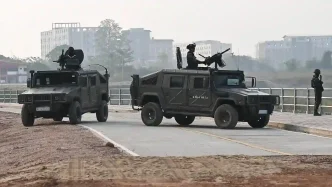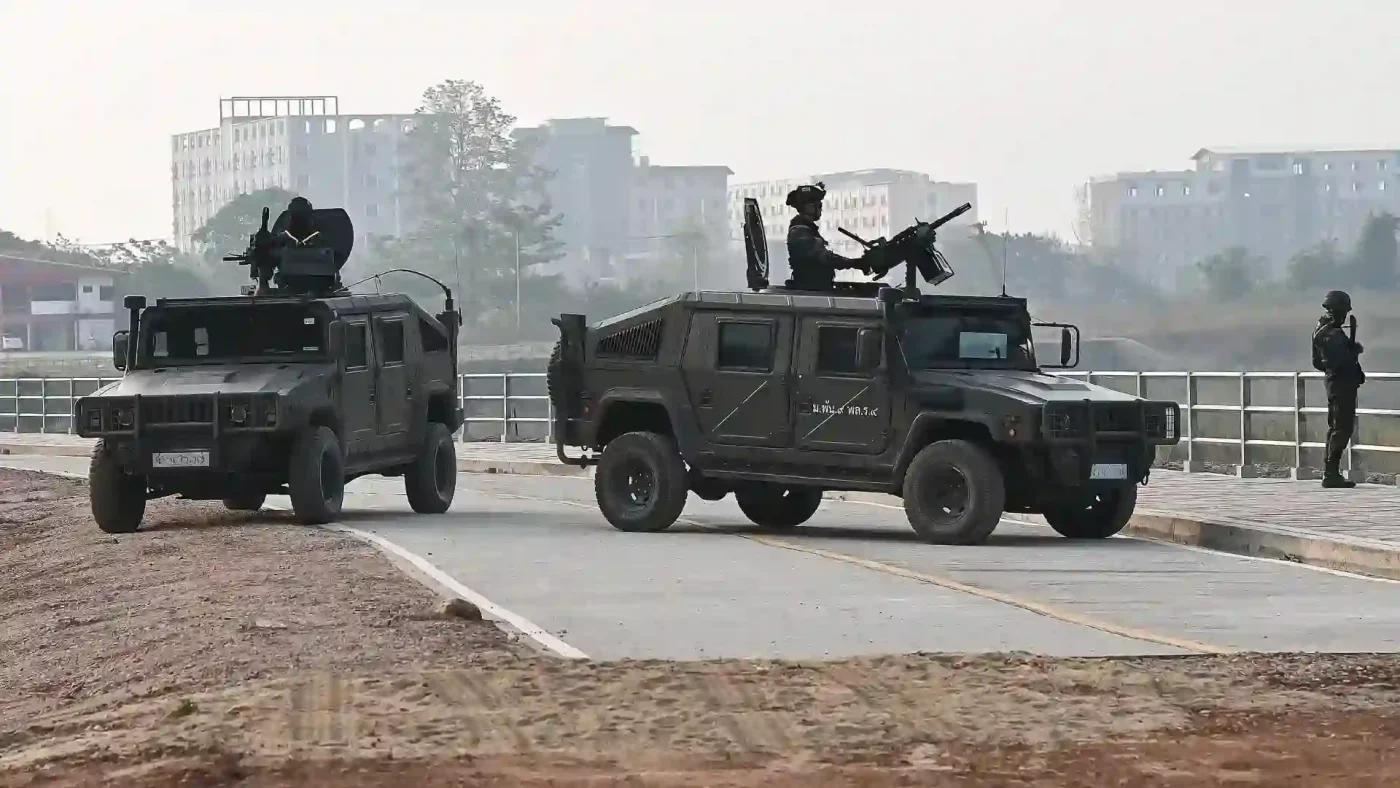Intensified fighting between Myanmar’s military and anti-government resistance forces near the Thai-Myanmar border has heightened tensions in the region, prompting Thai authorities to bolster security measures. Since early April, clashes have escalated, with resistance forces seizing a strategic command post just 10 kilometers from the border on April 19, 2025, marking a significant shift in the ongoing conflict. As skirmishes spill closer to Thai territory, questions loom over the potential impact on local communities and broader regional stability.
Conflict Intensifies Near Ban Phu Nam Ron
The latest surge in violence began on April 7, when anti-junta forces launched a series of coordinated attacks against Myanmar military positions. According to reports from the Lat Ya Task Force, a Thai military unit monitoring the border, resistance fighters achieved a critical victory by capturing a key command post near the Ban Phu Nam Ron Border Pass in Kanchanaburi province. This location, perilously close to Thai soil, has since become a focal point for continuous assaults on military bases by anti-government groups.
The proximity of the fighting to Thailand has raised alarms among Thai officials, who are wary of any spillover effects. The Ban Phu Nam Ron area, a historically sensitive border zone, serves as a vital crossing point for trade and migration, but it has also been a flashpoint during past conflicts in Myanmar. Thai authorities, through the Surasee Force and the Thai-Myanmar Border Command Centre, have been closely tracking developments, emphasizing the need to prevent any incursions or disruptions on their side of the border.
Thai Response: Heightened Security Measures
In response to the escalating unrest, the Lat Ya Task Force has coordinated with government agencies and local authorities to deploy additional personnel and military equipment along the border. Round-the-clock operations have been implemented to safeguard Thai communities near Ban Phu Nam Ron, with a focus on mitigating any potential impact from the fighting. Enhanced patrols and surveillance are now routine, as Thai forces aim to maintain order and protect national sovereignty.
Further bolstering these efforts, the Surasee Force has partnered with the Royal Thai Air Force (RTAF) to monitor aerial activity near the border. This precaution is designed to prevent any violations of Thai airspace by neighboring countries amid the regional unrest. While no specific incidents have been reported, the collaboration underscores Thailand’s determination to remain vigilant as the situation in Myanmar deteriorates.
Regional Implications of Myanmar’s Unrest
The ongoing conflict in Myanmar, which has persisted since the military coup in February 2021, continues to destabilize the region. Resistance forces, comprising a coalition of ethnic armed organizations and pro-democracy fighters, have gained ground in several areas, challenging the junta’s control over key territories. The seizure of the command post near the Thai border is seen by analysts as a bold escalation, signaling the growing capability and coordination of anti-junta groups.
For Thailand, the stakes are particularly high. The country shares a 2,400-kilometer border with Myanmar, much of it porous and difficult to monitor. Historically, conflicts in Myanmar have led to influxes of refugees, cross-border skirmishes, and disruptions to trade. Thai officials are keen to avoid a repeat of past crises, such as the mass displacement seen during earlier periods of violence in Myanmar. While no significant refugee movements have been reported in connection with the recent fighting, local communities near Ban Phu Nam Ron remain on edge, fearing potential fallout.
Beyond Thailand, the unrest has implications for the broader Southeast Asian region. Myanmar’s instability has long been a concern for the Association of Southeast Asian Nations (ASEAN), which has struggled to mediate a resolution to the crisis. Thailand, as a frontline state, plays a critical role in shaping regional responses, balancing humanitarian concerns with national security priorities. The current situation near Ban Phu Nam Ron could test ASEAN’s already strained diplomatic efforts to address Myanmar’s political turmoil.
Local Communities Caught in the Crossfire
While Thai military forces focus on securing the border, the human toll of the conflict remains a pressing issue. On the Myanmar side, civilians in areas near the fighting face significant risks, with reports of displacement and casualties emerging from conflict zones. Although detailed information is scarce due to restricted access, humanitarian organizations have expressed concern over the welfare of those caught in the crossfire.
In Thailand, residents of border communities in Kanchanaburi province are bracing for potential disruptions. Local businesses, many of which rely on cross-border trade, fear that intensified security measures or an escalation in violence could hamper their livelihoods. Thai authorities have pledged to minimize the impact on civilians, but the uncertainty of the situation continues to weigh heavily on those living near Ban Phu Nam Ron.
Historical Context: A Border Under Strain
The Thai-Myanmar border has long been a site of tension, shaped by decades of political upheaval in Myanmar. During the late 20th century, Thailand hosted waves of refugees fleeing military crackdowns and ethnic conflicts in Myanmar, particularly in border regions like Kayin (Karen) and Shan states. The current fighting near Ban Phu Nam Ron echoes these past struggles, reviving memories of instability for both Thai and Myanmar communities.
Thailand’s approach to border security has evolved over the years, with an emphasis on balancing deterrence with humanitarian considerations. However, the complexity of the current conflict in Myanmar—marked by a fragmented opposition and a military junta facing widespread resistance—presents unique challenges. Analysts note that the anti-junta forces’ recent successes near the border may embolden further attacks, potentially prolonging the unrest and complicating Thailand’s response.
International Reactions and Speculative Risks
The international community has taken note of the escalating violence near the Thai-Myanmar border, though responses remain cautious. Neighboring countries, including Laos and China, which also share borders with Myanmar, are monitoring the situation for potential ripple effects. While no official statements have been issued regarding the recent clashes near Ban Phu Nam Ron, regional observers speculate that sustained fighting could prompt calls for renewed diplomatic intervention.
Speculative concerns also linger over the possibility of military spillover into Thai territory. If confirmed, such an incident could strain Thailand’s relations with Myanmar’s junta and escalate tensions between the two nations. However, no evidence currently supports claims of direct incursions, and Thai forces appear well-positioned to prevent any immediate threats. The focus remains on containment, with authorities prioritizing de-escalation and border stability.
Looking Ahead: Challenges and Uncertainties
As the conflict near the Thai-Myanmar border unfolds, the path forward remains uncertain. Thai authorities face the dual challenge of securing their territory while navigating the humanitarian and diplomatic dimensions of Myanmar’s crisis. For now, the intensified military presence near Ban Phu Nam Ron serves as a stark reminder of the fragility of peace in the region.
Questions also persist about the long-term impact on Thailand’s border communities and the broader Southeast Asian landscape. Will the fighting subside, or could it mark the beginning of a more protracted struggle near Thailand’s frontier? As both sides in Myanmar’s conflict dig in, the answers may lie in the delicate balance of military strategy, regional cooperation, and the resilience of those living in the shadow of unrest.















